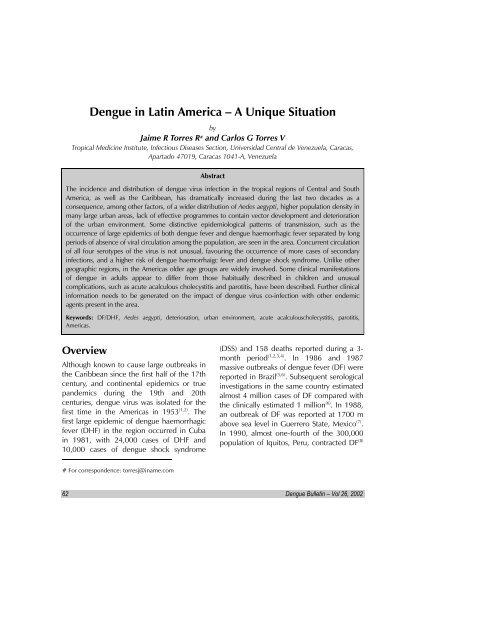Dengue Bulletin
Dengue Bulletin
Dengue Bulletin
- TAGS
- dengue
- bulletin
- 203.90.70.117
You also want an ePaper? Increase the reach of your titles
YUMPU automatically turns print PDFs into web optimized ePapers that Google loves.
<strong>Dengue</strong> in Latin America – A Unique Situation<br />
by<br />
Jaime R Torres R # and Carlos G Torres V<br />
Tropical Medicine Institute, Infectious Diseases Section, Universidad Central de Venezuela, Caracas,<br />
Apartado 47019, Caracas 1041-A, Venezuela<br />
Abstract<br />
The incidence and distribution of dengue virus infection in the tropical regions of Central and South<br />
America, as well as the Caribbean, has dramatically increased during the last two decades as a<br />
consequence, among other factors, of a wider distribution of Aedes aegypti, higher population density in<br />
many large urban areas, lack of effective programmes to contain vector development and deterioration<br />
of the urban environment. Some distinctive epidemiological patterns of transmission, such as the<br />
occurrence of large epidemics of both dengue fever and dengue haemorrhagic fever separated by long<br />
periods of absence of viral circulation among the population, are seen in the area. Concurrent circulation<br />
of all four serotypes of the virus is not unusual, favouring the occurrence of more cases of secondary<br />
infections, and a higher risk of dengue haemorrhaigc fever and dengue shock syndrome. Unlike other<br />
geographic regions, in the Americas older age groups are widely involved. Some clinical manifestations<br />
of dengue in adults appear to differ from those habitually described in children and unusual<br />
complications, such as acute acalculous cholecystitis and parotitis, have been described. Further clinical<br />
information needs to be generated on the impact of dengue virus co-infection with other endemic<br />
agents present in the area.<br />
Keywords: DF/DHF, Aedes aegypti, deterioration, urban environment, acute acalculouscholecystitis, parotitis,<br />
Americas.<br />
Overview<br />
Although known to cause large outbreaks in<br />
the Caribbean since the first half of the 17th<br />
century, and continental epidemics or true<br />
pandemics during the 19th and 20th<br />
centuries, dengue virus was isolated for the<br />
first time in the Americas in 1953 (1,2) . The<br />
first large epidemic of dengue haemorrhagic<br />
fever (DHF) in the region occurred in Cuba<br />
in 1981, with 24,000 cases of DHF and<br />
10,000 cases of dengue shock syndrome<br />
# For correspondence: torresj@iname.com<br />
(DSS) and 158 deaths reported during a 3month<br />
period (1,2,3,4) . In 1986 and 1987<br />
massive outbreaks of dengue fever (DF) were<br />
reported in Brazil (5,6) . Subsequent serological<br />
investigations in the same country estimated<br />
almost 4 million cases of DF compared with<br />
the clinically estimated 1 million (6) . In 1988,<br />
an outbreak of DF was reported at 1700 m<br />
above sea level in Guerrero State, Mexico (7) .<br />
In 1990, almost one-fourth of the 300,000<br />
population of Iquitos, Peru, contracted DF (8)<br />
62 <strong>Dengue</strong> <strong>Bulletin</strong> – Vol 26, 2002









